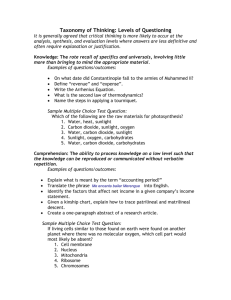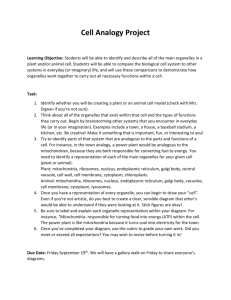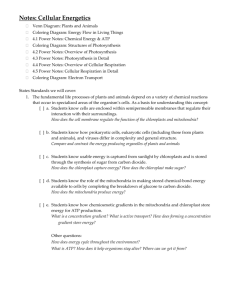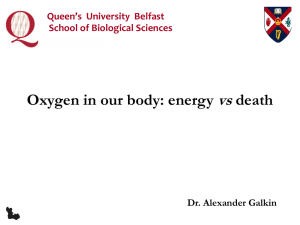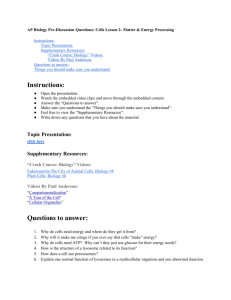I. Mitochondria Isolation
advertisement
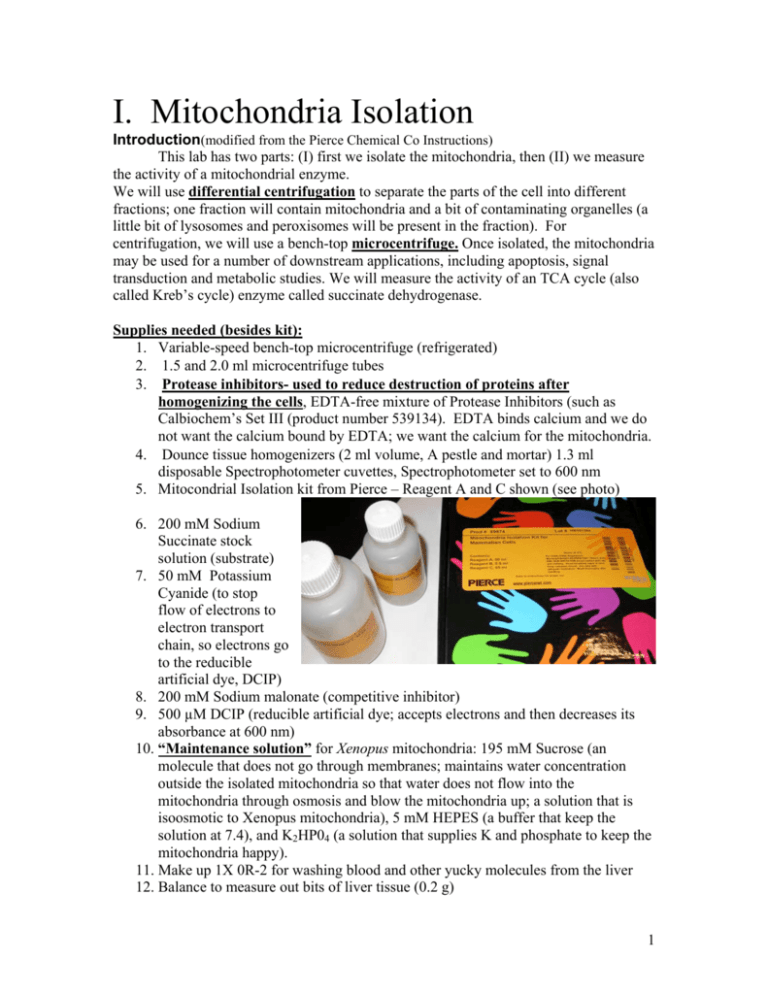
I. Mitochondria Isolation Introduction(modified from the Pierce Chemical Co Instructions) This lab has two parts: (I) first we isolate the mitochondria, then (II) we measure the activity of a mitochondrial enzyme. We will use differential centrifugation to separate the parts of the cell into different fractions; one fraction will contain mitochondria and a bit of contaminating organelles (a little bit of lysosomes and peroxisomes will be present in the fraction). For centrifugation, we will use a bench-top microcentrifuge. Once isolated, the mitochondria may be used for a number of downstream applications, including apoptosis, signal transduction and metabolic studies. We will measure the activity of an TCA cycle (also called Kreb’s cycle) enzyme called succinate dehydrogenase. Supplies needed (besides kit): 1. Variable-speed bench-top microcentrifuge (refrigerated) 2. 1.5 and 2.0 ml microcentrifuge tubes 3. Protease inhibitors- used to reduce destruction of proteins after homogenizing the cells, EDTA-free mixture of Protease Inhibitors (such as Calbiochem’s Set III (product number 539134). EDTA binds calcium and we do not want the calcium bound by EDTA; we want the calcium for the mitochondria. 4. Dounce tissue homogenizers (2 ml volume, A pestle and mortar) 1.3 ml disposable Spectrophotometer cuvettes, Spectrophotometer set to 600 nm 5. Mitocondrial Isolation kit from Pierce – Reagent A and C shown (see photo) 6. 200 mM Sodium Succinate stock solution (substrate) 7. 50 mM Potassium Cyanide (to stop flow of electrons to electron transport chain, so electrons go to the reducible artificial dye, DCIP) 8. 200 mM Sodium malonate (competitive inhibitor) 9. 500 µM DCIP (reducible artificial dye; accepts electrons and then decreases its absorbance at 600 nm) 10. “Maintenance solution” for Xenopus mitochondria: 195 mM Sucrose (an molecule that does not go through membranes; maintains water concentration outside the isolated mitochondria so that water does not flow into the mitochondria through osmosis and blow the mitochondria up; a solution that is isoosmotic to Xenopus mitochondria), 5 mM HEPES (a buffer that keep the solution at 7.4), and K2HP04 (a solution that supplies K and phosphate to keep the mitochondria happy). 11. Make up 1X 0R-2 for washing blood and other yucky molecules from the liver 12. Balance to measure out bits of liver tissue (0.2 g) 1 13. 2 ml Dounce Homogenizer (mortar and pestle) 14. Transfer Pipettes 15. Ice bucket and ice 16. Parafilm and scissors to cut up the liver 17. Timers 18. A scale to weigh out 0.2 g of liver tissue and BSA Below: arrows point to two livers in frog Isolation of Mitochondria using Dounce Homogenization and a Centrifuge 1. Put 0.8 ml of 0.8 ml of Reagent A into a V vial and add 1.4 µl of Protease Cocktail. Into another v vial (mark the tubes with identifying mark) add 0.8 ml of Reagent C and add 1.4 µl of Protease Cocktail. Protease cocktail (see web site pdf file) has inhibitors of degradative proteases that will destroy cellular proteins. 2. To the two v vials containing Reagent A or C, add BSA (bovine serum albumin; a “generic” protein) to a final concentration 4 mg/ml. BSA helps remove lipids that make the solution opaque and interfere with the reading in the spectrophotometer. 3. Put Dounce Tissue homogenizer and a couple of 1.5 and 2 ml v vials into the ice (ice cold temperatures keep degradative enzymes from destroying the mitohcondria). 4. Take 200 mg of the liver (this is about 1/3th of an inch cube) and put into a 15 ml small Petri dish filled with OR-2. Liver is kept on ice. Wash away blood with more 0R2, and then cut up the liver into small pieces with iris scissors. 2 5. Remove (decant) excess OR-2 and place “liver bits” into a 2 ml Glass Dounce Homogenizer. Remove excess solution, wash liver bits a second time, remove excess solution. 6. Add 800 µl of Mitochondria Isolation Reagent A (reagent A already has BSA and protease cocktail) and homogenize cells on ice- using glass Dounce pestle. The mortar is the container- the pestle is the part you put down into the mortar). USE a loose fitting pestle or mitochondria will be torn apart. Count how many times you go up and down and record this in your lab notebook (this seemingly unimportant detail is important!! a cell biologists will ask you how many times did this- it could be 10 to 70 up and down strokes with the pestle) to break up the liver into particles. Record everything in your lab notebook (did you breathe will homogenizing?). 7. Add 800 µl of Reagent C (which also already has protease cocktail and BSA). 8. Invert tube several times to mix (do not vortex-this is too harsh for mitochondria). 9. Put into a locking 2 ml microcentrifuge tube (see picture) and centrifuge at 700 x g for 10 minutes at 4°C. This removes entire unhomogenized cells and general liver crud from your mitochondria. Although intact cells will be put into the pellet, mitochondria are smaller and they remain in the supernatant (this is differential centrifugation). In this centrifuge (also called microfuge), the samples in the 2 ml “v vial” (microcentrifuge tube) are placed into holes in the rotor. REMEMBER to put the clear lid on top before you close the lid and start it up. Note that on the left top of the control panel there is a button that is used to switch from RPM (rev per min) to RCF (relative centrifugal force). We want RCF (which is in xg), and we will run the centrifuge at 700xg and 3000xg. 10. Transfer the supernatant which has the mitochondria (discard pellet crud) to a new, 2.0 ml tube and centrifuge at 3 3,000 xg for 15 minutes at 4°C. The mitochondria are now in the pellet. We could centrifuge at a higher speed (12,000xg) to obtain more mitochondria but we would also have more contaminating peroxisomes and other organelles. 11. The pellet has mitochondria but the surface of the pellet has mitochondria that are partially destroyed. So, when the bad mitochondria away by washing the surface of the mitochondrial pellet. Add 500 µl of “mitochondrial maintenance buffer” (195 mM Sucrose, 5 mM Tris pH 7.4; 20 mM K2HP04 ) to the 2 ml V vial. Wash a second time. 12. Mitochondria are believed to be more stable in the pellet (the pellet keeps oxygen away) and you can make the pellet into a paste by using a probe and mixing it up. Keep the mitochondria paste on ice (freezing mitochondria at this point would blow them up and destroy membranes, so we have to make the mitochondria fresh). B. OPTIONAL PART: When you prepare different samples for analysis, you always worry that one test tube contains more mitochondria than another. So to make sure that each test tube has the same number of mitochondria, you measure the amount of protein in each test tube. To do this, you take a small sample from each tube and use a kit like the BCA™ Protein Assay Kit (Product No. 23225 Pierce). Mitochondria may be lysed with 2% CHAPS in Tris buffered saline (TBS; e.g., 25 mM Tris, 0.15 M NaCl; pH 7.2; Product No. 28379) as described below: 1. Add 100 µl of 2% CHAPS in TBS to the mitochondrial pellet and vortex for 1 minute. 2. Centrifuge mitochondria at high speed for 2 minutes. The supernatant contains soluble mitochondrial protein that can be analyzed by BCA™ Protein Assay. Next section is modified from the iWorx manual: 4 Mitochondrial Metabolism Overview This laboratory uses the mitochondria isolated from Xenopus liver cells and examines an enzyme in the TCA Cycle. Enzyme activity can be measured by disappearance of reactants (e.g., succinate) or appearance of products (like fumarate). It is easier to measure another product of this reaction -the release of electrons from succinate. The release of electrons will be measured through use of a dye that turns from blue to clear when the dye binds electrons (the dye is reduced). The initial stages of glucose breakdown take place in the cytoplasm where it is converted to pyruvic acid by a process called glycolysis. Pyruvic acid is moved into the mitochondria, where it is broken down further by the TCA or Kreb’s Cycle to form water, carbon dioxide and ATP. In this laboratory you will examine one step within the Krebs cycle: the oxidation of succinic acid to fumaric acid, a reaction which is catalyzed by the mitochondrial enzyme succinic dehydrogenase (SDH). Flavin adenine dinucleotide (FAD) accepts electrons are stripped from succinate (remember, in succinate, the 2 bonds between two carbons and hydrogen atoms are broken, and electrons are taken from the broken covalent bonds). The oxidation of succinic acid is accompanied by the reduction of FAD. The reduced FAD passes its electrons through the electron transport system, where they are eventually passed to molecular oxygen to form water. However, we will add an artificial reducible dye that will steal the electrons. SDH is locked into the inner mitochondrial membrane of the mitochondria (other TCA cycle enzymes are soluble and they will float away if the mitochondria are broken open). As compared with other TCA cycle enzymes, a second reason why SDH activity is measured is that SDH is the most active enzyme in the TCA cycle. A reducible, artificial dye will be added and it will absorb some of the electrons produced by the reaction. When the dye absorbs electrons, the dye will absorb less light; you will monitor this change using a spectrophotometer. You will make up a solution with cyanide. Cyanide stops the transfer of electrons to the electron transport chain, thus, cyanide will stop electrons from going to FAD and the electron transport chain; forcing the electrons to go to the artificial dye. Obviously, since cyanide will stop electrons going on to the electron transport chain, in a human, the cyanide will stop ATP production (a crucial “battery” that makes certain biochemical reactions take place –reactions that keep us alive!). Finally, you will examine the effect of a competitive inhibitor (malonate) on succinate dehyrogease activity (as noted, the activity is measured by the rate of electrons given to the reducible, artificial dye). Electron Transport Inhibitors prevent electrons from being passed from one membrane protein or electron carrier to another. This stops the flow of electrons, all chemical reactions up to that point back up (stop), and no ATP is made. Rotenone (insecticide), animycin, and cyanide (inhibits a protein in the electron transport chain called cytochrome oxidase). NOTE: Solutions All solutions should be refrigerated or kept on ice. 5 Note: Do not pipette any solutions by mouth. You are working with potassium cyanide! Use micropipettes. Enzyme Assay PROCEDURE 1 Turn on the spectrophotometer. Set the wavelength to 600nm by pressing button number 5 and allow the instrument to warm up for at least 15 minutes. 2. After washing the surface of the mitocondrial pellet, remove all excess solution. Then add 0.8 ml of mitochondrial maintenance buffer, and scrape the pellet into it. 3. Put the 0.8 ml of liver extract (mitochondria) into a 1.3 ml disposable cuvette (see picture to the right). 4. Zero the Spectrophotometer (see picture) by pressing Blank. Now the spec should read 0.00. If the liver solution is too concentrated (the dark red color is from Fe in the membrane proteins), then the spec will read +++++++++++++ and you will have to dilute. If you have to dilute, try adding 200 µl of mitochondrial maintenance buffer. 5. Add the following 3 ingredients into a 1.5 ml V vial: a. Add 80 µl of 500 µM DCIP to achieve a final concentration of 50 µM. b. Add 32 µl of 50 mM K cyanide (KCN) for a final concentration of 2 mM. KCN solutions are volatile (so do not breathe in around solution) and this means that the solution looses potency with time and if the cap of the solution is left off. c. Add 40 µl of 200 mM Na Succinate to a final concentration of 10 mM 6. Get everything ready; your timer and bit of Parafilm for mixing- start the timer the second that you add substrate AND invert to mix AND punch the button reading SAMPLE on the Spectrophotometer (this is a team effort). Enzyme reactions are typically begun with the addition of substrate (succinate). OD600 at time zero (just after addition of 3 ingredients and mixing): _________ (Punch the SAMPLE button on the spec at the following times and record the reading) 30 sec 60 s 90 s 120 s 150 s 180 s 5 min 6 10 min 15 min 20 min We may not get to these experiments on the first day: a. We will also examine the effect of the competitive inhibitor. Repeat protocol but add 40 µL of 200 mM Malonate before you add the succinate. OD600 at time zero (just after addition of 3 ingredients and mixing): _________ (Punch the SAMPLE button on the spec at the following times and record the reading) 30 sec 60 s 90 s 120 s 150 s 180 s 5 min 10 min 15 min 20 min b. We will also examine the effect of metformin (also called Glucophage): There are two models of how metformin helps diabetics: 1. that it stimulates the insulin receptor 2. that it inhibits the mitochondria, and this lowers ATP and raises AMP concentration in the cell. High AMP concentration stimulates a kinase that results in helping insulin action. Will metformin (at 1, 10 or 100 ug/ml) inhibit Succinate dehydrogenase? Incubate with metformin for up to an hour to an hour and a half before adding dye and the other chemicals. c. Enzyme kinetics: Vary the concentration of Succinate and see what this does to the rate of the enzyme-catalyzed reaction. Use 0.2 mM, 0.5 mM, 1 mM, or 5 mM [Succinate]. We will pool all samples of isolated mitochondria so that everyone has the same concentration of mitochondria. If someone had a more concentrated solution of mitochondria, could you compare their data with those that had a dilute solution of mitochondria? Why or why not? Write the concentration of succinate that you have been assigned here: Get timers ready, zero spec with just mitochondria then record OD600 at time zero (just after addition of 3 ingredients and mixing): _________ 30 sec 60 s 90 s 120 s 150 s 180 s 5 min 10 min 15 min 7 Data Analysis 1. Using Sigmaplot, graph absorbance (also called optical density at 600 nm or OD600) as a function of time. Use linear regression analysis to find the best line for each reaction. See if a second order regression results in better fit (we typically use first orderhow would you select second order with SigmaPlot?). A better fit to the data would be seen by a R2 value that is closer to 1.0. First order: y = mx +b and Second order: y = mx + nx2 + b (is 2nd order a better fit to the data? Do the data show a change in the slope after the first five minutes?). The slope m (what does SigmaPlot call it?) is the rate of the reaction. Remember that slope is the change in Y values over the change in X values; here, the units of the units of the slope would be the OD600 change/time in minutes. 2. Do we need to make the data into a straight line? How would we do this? (hint: semilog). Why would the rate slow down after 5-10 min? Think in terms of amount of substrate or dye. If the slope changes (that is, the slope is steeper in the first five min or so, but less steep later), you could find the slope for the first five min (a large number) and then for the later time period (a smaller number). 3. Change the slope (change in OD 600 per min) to nanomoles of DCIP reduced per minute. To do this, you need to know that one OD 600 unit (1.0 on the spec) is equal to 4.5 micromolar DCIP. A slope (equal to the rate of the reaction) in the correct units might be 3.5 nmoles of DCIP/min. 4. Explain the effect of malonate by comparing the slopes of the lines with and without malonate. Explain competitive inhibition. 5. Predict what you would expect if you did not add cyanide….if you did not add succinate (compare slopes). 6. Discuss methods used to isolate organelles (use the pertinent sections of your text). 7. Calculate the final concentration of the various inhibitors found in the protease inhibitor cocktail (using 1.6 µl of cocktail added to a total volume of 1.8 ml: 1.6 ml of Reagent A and C and about 0.2 ml of liver). 8. Enzyme kinetics: If you varied the concentration of substrate, graph the data. Compare the slopes of OD600 vs. time with the data from different succinate concentrations. For each concentration, you would obtain a line and a slope. Obtain the rate of the reaction with these different succinate concentrations (in these units: nmoles of DCIP/min). You would expect a steep drop (high slope; slope is a big number) with higher concentrations of Succinate. In a second figure, graph the rate of the reaction versus the concentration of succinate. What is the shape of the line called? (use your textbook, chapter 6). Why does the line become horizontal at high substrate concentration? What is Km and Vm? Point out where on the graph these constants are and give numerical values for each (what are their units?). In a third figure, show the double reciprocal plot (see PowerPoint notes and your textbook) to find Km and Vm (even if the data are poor, you can tell me how you would use the double reciprocal plot). 8

